Field Redevelopment and Weight Shedding for Decommissioning of Offshore Facilities
Abstract
:1. Introduction
2. Case Study
2.1. Field Description
2.2. Requirements of Weight Shedding
2.3. Weight Shedding Basis
- Plan that would entail the progressive weight management of the platforms, with items needing to be weighed and located as they are removed and added so that the weight and CoG of the topsides would be able to be calculated at each stage.
- Topside weight estimates are currently limited due to the available data for equipment and bulks being limited to weights contained in analysis models, which are not completely reliable and do not distinguish operating from dry weights. Addressing this would entail a detailed weight audit of the platforms in advance of the operations.
- Additional structural analyses could be performed to address interim conditions to verify that structural capacities are not exceeded at each stage.
- Simultaneous construction and demolition safety implications, which would entail a specific safety management plan—agreed and approved—as well.
- Removal of part of the topsides or substructures may affect the load path of the remaining loads.
- Topside weight reduction is also likely to make possible an increase in potential tension in jacket piles (for instance on a jacket left in place for unrestricted weather conditions).
- Topside weight modification may affect the platform period and its dynamic response to waves.
- Removal of part of the topsides is likely to induce impact loads on the remaining structure (typically, reversed topsides float over or lift a module from existing topsides).
- Mooring of barge or vessel to a platform during a removal operation.
2.4. Asset Overview for PS3B Production Platform
2.5. Permanent Isolation and Cleaning of Topside Facilities and Pipelines
2.6. Heavy-Lift Vessel Locations
2.7. Topside Weight Shedding
2.7.1. Weight Shedding Overview
2.7.2. Upper Deck Weight Shedding
2.8. Lower Deck Weight Shedding
3. Benefits and Challenges of Weight Shedding in Decommissioning
3.1. Cost Reduction
3.2. Measures to Reduce Environmental Impact
3.3. Resource Optimisation
3.4. Carbon Emissions
3.5. Technological Challenges
4. Future Directions of Weight Shedding in Decommissioning
4.1. Advanced Structural Analysis Techniques
4.2. Automation and Robotics
4.3. Material Recycling and Reuse
4.4. Policy and Regulatory Frameworks
5. Conclusions
- Installation and commissioning of temporary equipment (power, air, light, etc.) that meets the appropriate performance standards for the decommissioning and abandonment plan.
- Draining, flushing, purging, and venting of the hydrocarbon process system.
- Processing boundary isolations wherever installed.
- Engineering down and cleaning all systems on the offshore platform.
- Providing global electrical isolations on the platform and switching over to temporary systems.
- Completing the pre-commissioning of greenfield facilities.
Author Contributions
Funding
Informed Consent Statement
Data Availability Statement
Conflicts of Interest
Appendix A. Decommissioning and Abandonment
- Engineer down and clean/make safe.
- Risk and opportunity management.
- Topside preparation/weight shedding.
- Topside and jacket removal.
- Onshore disposal.
- Environmental management.
Appendix A.1. Engineer Down and Clean/Make Safe
- Identify health, safety, security, and environmental (HSSE) hazards and document their effects on people, assets, environment, and reputation in a hazards and effects register.
- Assess the risk of identified hazards for worst-case credible scenarios using the risk assessment matrix (RAM).
- Apply the hierarchy of controls for managing risk (see Figure A1).
- Where reasonably practicable, eliminate hazards or substitute hazards with ones having lower risk.
- Identify and implement control and recovery measures to reduce risks to ALARP.
- Actively seek out and, where reasonably practicable, select the lowest risk options.
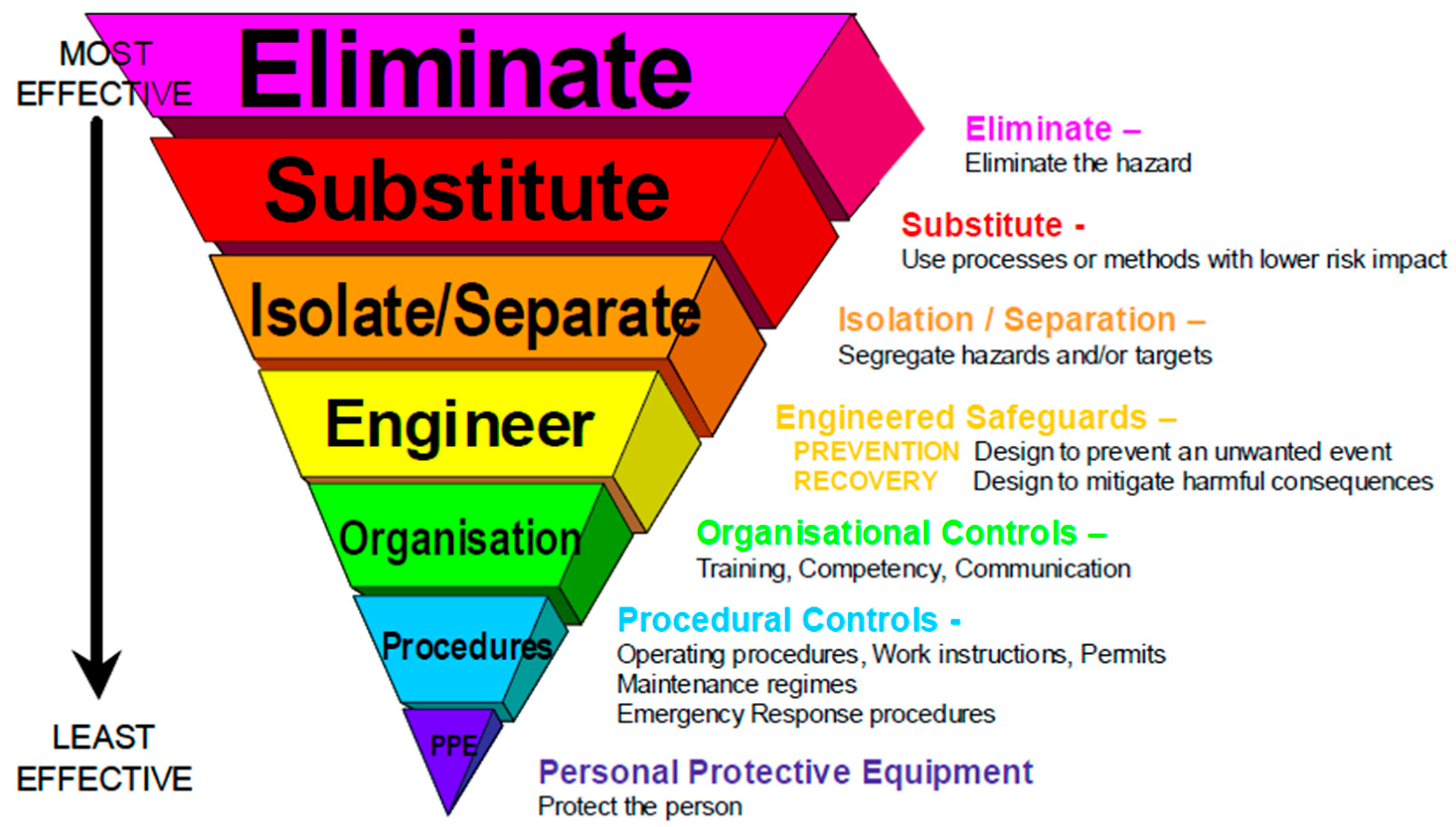
Appendix A.2. Risk and Opportunity Management
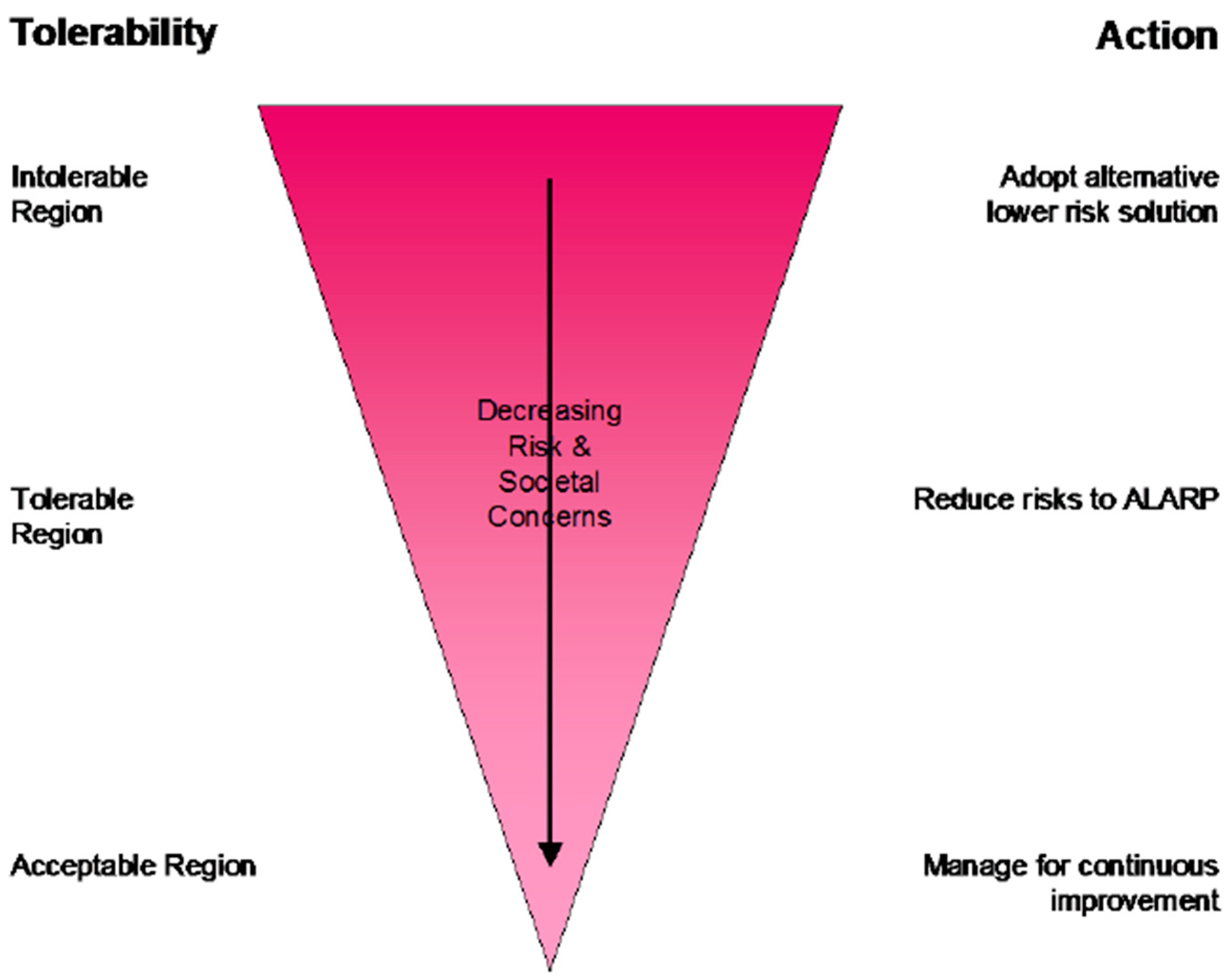
Appendix A.3. Topside Preparation/Weight Shedding
Appendix A.4. Topside and Jacket Removal
Appendix A.5. Onshore Disposal
Appendix A.6. Environmental Management
- All potential impacts on the marine environment, including exposure of biota to contaminants associated with the installation, other biological impacts arising from physical effects, conflicts with the conservation of species, with the protection of their habitats, or with mariculture, and interference with other legitimate uses of the sea.
- All potential impacts on other environmental compartments, including emissions to the atmosphere, leaching to groundwater, discharges to surface fresh water, and effects on the soil.
- Consumption of natural resources and energy associated with reuse and recycling.
- Other consequential effects on the physical environment which may be expected to result from the option.
- Potential impacts on amenities, the activities of communities, and future uses of the environment.
Appendix B. Decommissioning Breakdown
Appendix B.1. Project Management
Appendix B.2. Post-CoP Running Costs
Appendix B.3. Well Decommissioning
- Permanent isolation of the reservoir.
- Permanent isolation of any intermediate zones with flow potential. This phase is considered complete when all required barriers are in place.
- A well is considered fully decommissioned after removing the wellhead and conductor, the well origin at the surface is removed, and the well will never be reused or entered again.
Appendix B.4. Permanent Isolation and Cleaning of Facilities and Pipelines
- Protection of personnel from exposure to hazardous wastes.
- Protection of the environment from uncontrolled discharges.
- Minimising fuel sources which could pose fire and explosion hazards.
- Allowing reclassification of hazardous areas as and when flammable hazards are permanently removed.
- Facilitating future preparation for the removal of the topsides, transportation, and disposal. The required cleaning work not only includes the removal of hydrocarbons and other hazardous fluids but also considers hazardous materials such as asbestos and radioactive substances such as those found in nucleonic level detection instruments.
Appendix B.5. Temporary Utility and Life Support Systems
- Power generation system.
- Power distribution system.
- Diesel fuel storage and distribution system.
- Air compressor and distribution system.
- Seawater supply and distribution system for flushing.
- Instrument and telecommunication facilities.
Appendix B.6. Preparation for Idle Phase
Appendix B.7. Disconnection—Preparation for Removal
- Structural separation: temporary and secondary steelwork (e.g., walkways, stairs, seal welds, etc.).
- Piping separation: process and utility pipework and supports.
- Electrical and instrument separation: power, instrument and control cables, cable trays, light fittings, etc.
- Heating, ventilation, air conditioning (HVAC) separation: vent ducts.
- Caissons, risers and J-tube separation.
Appendix B.8. Topside Removal
| Option | Description | Advantages | Disadvantages |
|---|---|---|---|
| Reverse Installation/Individual Module Removal | Most of the PS topsides were installed in individual modules. | Lower chance of having to strengthen modules as the modules were designed for this lifting method. | A large amount of offshore separation work. |
| Singe Lift | Due to the increase in capacity of offshore HLVs, it may be possible to lift more than one of the modules at any one time. | Fewer offshore lifts; less separation to be undertaken offshore. | Strengthening of modules may be required, especially at lifting points, due to greater weight to be removed. |
| Piecemeal Removal | The topsides would be broken down offshore and loaded onto barges using the HLV cranes. An analysis of the order of removal would be performed in the planning for the decommissioning phase. | HLV is only needed for the very last stage. A large proportion of work will be able to be completed using a platform crane (if available). | More offshore separation works, therefore greater offshore programme. Analysis will be required to determine the stability of cranes throughout demolition works. |
Appendix B.9. Substructure Removal
| Option | Description | Advantages | Disadvantages |
|---|---|---|---|
| Jacket piecemeal removal. | Jackets, footings, and piles would be cut into small manageable pieces and lifted to the surface to be transported to shore. | Lift weights are lower, so greater competition of HLV. Easier to offload at the disposal yard, especially if barge-loaded. | Many underwater cuts at great depth; environmental, programme, and cost issues. A large number of lifts. |
| The jacket is removed in a single lift by HLV. | Piles are excavated and cut at a level agreed with the regulator. Jacket lifted by HLV to a barge or transported to shore in the hook. | A small number of underwater cuts are required. Reduced offshore programme. If there is sufficient crane height, the jacket upending can be avoided, simplifying the lift. | If readily available HLV capacity is exceeded, the option to remove in two sections may be more economical than a larger capacity vessel. |
Appendix B.10. Onshore Disposal
- Offshore operations.
- Topside and jacket disposal.
- Subsea infrastructure.
- Flushed process fluids containing hazardous materials.

- Distance of disposal yard from the platform.
- Accessibility of the yard from the sea.
- Offloading and heavy-lift capabilities.
- Laydown area/yard space.
- Security arrangements.
- Watertight floored space/covered storage capacity.
- HSSE management plans.
- Waste management systems.
- Material control procedures.
References
- Bull, A.S.; Love, M.S. Worldwide oil and gas platform decommissioning: A review of practices and reefing options. Ocean Coast. Manag. 2018, 168, 274–306. [Google Scholar] [CrossRef]
- Elchalakani, M.; Kimiaei, M.; Reda, A.; Yang, B. Repair and strengthening of offshore platforms topside girders using externally bonded fibre-reinforced polymers. Ocean. Eng. 2023, 272, 113313. [Google Scholar] [CrossRef]
- Amaechi, C.V.; Reda, A.; Butler, H.O.; Ja’e, I.A.; An, C. Review on fixed and floating offshore structures. Part I: Types of platforms with some applications. J. Mar. Sci. Eng. 2022, 10, 1074. [Google Scholar] [CrossRef]
- Amaechi, C.V.; Reda, A.; Butler, H.O.; Ja’e, I.A.; An, C. Review on fixed and floating offshore structures. Part II: Sustainable design approaches and project management. J. Mar. Sci. Eng. 2022, 10, 973. [Google Scholar] [CrossRef]
- Wilkinson, W.B.; Bakke, T.; Clauss, G.F.; Clements, R.; Dover, W.D.; Rullkötter, J.; Shepherd, J.G. Decommissioning of large offshore structures—The role of an Independent Review Group (IRG). Ocean. Eng. 2016, 113, 11–17. [Google Scholar] [CrossRef]
- Pollett, B.B. Risk-Based Offshore Decommissioning Standards and Regulations. In Proceedings of the Offshore Technology Conference, Houston, TX, USA, 4–7 May 2020. [Google Scholar] [CrossRef]
- Techera, E.J.; Chandler, J. Offshore installations, decommissioning and artificial reefs: Do current legal frameworks best serve the marine environment? Mar. Policy 2015, 59, 53–60. [Google Scholar] [CrossRef]
- Smyth, K.; Christie, N.; Burdon, D.; Atkins, J.P.; Barnes, R.; Elliott, M. Renewables-to-reefs?—Decommissioning options for the offshore wind power industry. Mar. Pollut. Bull. 2015, 90, 247–258. [Google Scholar] [CrossRef] [PubMed]
- Chandler, J.; White, D.; Techera, E.J.; Gourvenec, S.; Draper, S. Engineering and legal considerations for decommissioning of offshore oil and gas infrastructure in Australia. Ocean. Eng. 2017, 131, 338–347. [Google Scholar] [CrossRef]
- Hall, R.; Topham, E.; João, E. Environmental Impact Assessment for the decommissioning of offshore wind farms. Renew. Sustain. Energy Rev. 2022, 165, 112580. [Google Scholar] [CrossRef]
- Gorman, D.G.; Neilson, J. Decommissioning Offshore Structures; Series Title: Environmental Science and Engineering; Springer: London, UK, 1998. [Google Scholar] [CrossRef]
- Shams, S.; Prasad, D.R.; Imteaz, M.A.; Khan MM, H.; Ahsan, A.; Karim, M.R. An Assessment of Environmental Impact on Offshore Decommissioning of Oil and Gas Pipelines. Environments 2023, 10, 104. [Google Scholar] [CrossRef]
- Junior FJ, C.; Bressan RD, S.; Nicolosi, E.R.; Santana AL, B.; De Souza, D.C.; Fernandes, P.T.; Tavares, G.M. Cost Reduction Challenges in Subsea Decommissioning Operations. In Proceedings of the Offshore Technology Conference, Houston, TX, USA, 1–4 May 2023; p. D031S039R001. [Google Scholar] [CrossRef]
- Bressan, R.S.; Artigas, D. Task Scheduling for Subsea Flexible Pipes Decommissioning. In Proceedings of the Offshore Technology Conference, Houston, TX, USA, 16–19 August 2021. [Google Scholar] [CrossRef]
- Reda, A.; Amaechi, C.V.; Diaz Jimenez, L.F.; Sultan, I.A.; Rawlinson, A. Guideline for the Decommissioning/Abandonment of Subsea Pipelines. J. Mar. Sci. Eng. 2024, 12, 8. [Google Scholar] [CrossRef]
- Reda, A.; Amaechi, C.V.; Shahin, M.A. Case study for effects of pile installation on existing offshore facilities in brownfields. Appl. Ocean. Res. 2023, 138, 103651. [Google Scholar] [CrossRef]
- Kaiser, M.J. A review of onshore and offshore pipeline construction and decommissioning cost in the USA-part 1: Specifications, cost estimation and onshore construction. Int. J. Oil Gas Coal Technol. 2021, 27, 247–285. [Google Scholar] [CrossRef]
- Kaiser, M.J. BSEE decommissioning cost estimates in the shallow water US Gulf of Mexico. Ships Offshore Struct. 2023, 18, 1482–1496. [Google Scholar] [CrossRef]
- Bijker, R.; Chen, Z. Prediction model for decommissioned offshore pipelines. In Proceedings of the ISOPE International Ocean and Polar Engineering Conference, Stavanger, Norway, 17–22 June 2001; p. ISOPE-I. [Google Scholar]
- Jas, E.; Selman, A.; Linton, V. Out of sight out of mind–subsea pipeline decommissioning. APPEA J. 2017, 57, 79–87. [Google Scholar] [CrossRef]
- Shen, Y.; Birkinshaw, P.; Palmer-Jones, R. Challenges in offshore pipeline decommissioning and what can we learn from integrity management practices. In Proceedings of the ISOPE International Ocean and Polar Engineering Conference, San Francisco, CA, USA, 25–30 June 2017; p. ISOPE-I. [Google Scholar]
- Koroma, S.G.; Animah, I.; Shafiee, M.; Tee, K.F. Decommissioning of deep and ultra-deepwater oil and gas pipelines: Issues and challenges. Int. J. Oil Gas Coal Technol. 2019, 22, 470–487. [Google Scholar] [CrossRef]
- Raitt, P.; Selman, A.; Lanoëlle, C. Engineering and environmental studies for decommissioning of subsea infrastructure. APPEA J. 2019, 59, 277–288. [Google Scholar] [CrossRef]
- Anderson, J.M. Decommissioning pipelines and subsea equipment: Legislative issues and decommissioning processes. Underw. Technol. 2002, 25, 105–111. [Google Scholar] [CrossRef]
- Tularak, A.; Ali Khan, W.; Thungsuntonkhun, W. Decommissioning challenges in Thailand. In Proceedings of the SPE Asia Pacific Health, Safety, Security, Environment and Social Responsibility Symposium, Bangkok, Thailand, 10–12 September 2007; p. SPE-108867. [Google Scholar]
- Greca, A.D. Decommissioning & removal options: Which choice? In Proceedings of the ISOPE International Ocean and Polar Engineering Conference, Los Angeles, CA, USA, 26–31 May 1996; p. ISOPE-I. [Google Scholar]
- MacKenzie, H.; Jones, C. Cost Reducing Pipeline Decommissioning Technology. In Proceedings of the SPE Offshore Europe Conference and Exhibition, Aberdeen, UK, 8–11 September 2015; p. SPE-175487. [Google Scholar]
- Smith, R.W. An Assessment of Current US Pipeline Flushing Practice and Decommissioning Requirements: How Clean Is Clean? In Proceedings of the International Conference on Offshore Mechanics and Arctic Engineering, Oslo, Norway, 23–28 June 2022; Volume 36142, pp. 33–38. [Google Scholar]
- Yap, T.L. Planning & Execution of Field 1 Subsea Facilities Decommissioning. In Proceedings of the SPE Symposium: Decommissioning and Abandonment, Kuala Lumpur, Malaysia, 3–4 December 2018; p. D011S004R002. [Google Scholar]
- Krause, P.; Baquiran, J. Determining Environmentally Superior Decommissioning Options for Hard and Flexible Pipelines. In Proceedings of the SPE Symposium: Decommissioning and Abandonment, Kuala Lumpur, Malaysia, 3–4 December 2019; p. D011S002R003. [Google Scholar]
- Philip, N.S.; Wilde, S.; Arshad, R.; Washash, I.; Al-Sayed, T.A. Decommissioning process for subsea pipelines. In Proceedings of the Abu Dhabi International Petroleum Exhibition and Conference, Abu Dhabi, United Arab Emirates, 10–13 November 2014; p. D021S035R005. [Google Scholar]
- UKOOA. Industry Guidelines on a Framework for Risk Related Decision Making; UK Offshore Operators Association: Aberdeen, UK, 1999. [Google Scholar]
- ISO 14001:2015; Environmental Management Systems—Requirements with Guidance for Use. ISO: Geneva, Switzerland, 2015. Available online: https://www.iso.org/standard/60857.html (accessed on 1 June 2024).
- IMO Resolution A.672 (16) Guidelines and Standards for the Removal of Offshore Installations and Structures on the Continental Shelf and in the Exclusive Economic Zone. Adopted on 19 October 1989. Available online: https://wwwcdn.imo.org/localresources/en/KnowledgeCentre/IndexofIMOResolutions/AssemblyDocuments/A.672(16).pdf (accessed on 1 June 2024).
- OSPAR Commission. OSPAR Convention. In Convention for the Protection of the Marine Environment of the North-East Atlantic; Text as Amended on 24 July 1998, Updated 9 May 2002, 7 February 2005 and 18 May 2006; Amendments to Annexes II and III Adopted at OSPAR 2007; OSPAR Commission: Paris, France, 1992. [Google Scholar]
- Jones, C.M.; Boisvert, M.B.; Dolbel, S.L.; Langsford, R.P.; Farag, G.N.; Rinaldi, K.A.; Brauhart, J.D.; Hoffman, P.Y.; Brunsdon, G.A. Key lessons in planning for proactive decommissioning–a review of the Thevenard Island decommissioning project. APPEA J. 2022, 62, 1–13. [Google Scholar] [CrossRef]
- Jones, D.O.; Gates, A.R.; Huvenne, V.A.; Phillips, A.B.; Bett, B.J. Autonomous marine environmental monitoring: Application in decommissioned oil fields. Sci. Total Environ. 2019, 668, 835–853. [Google Scholar] [CrossRef]
- Tan, Y.; Li, H.X.; Cheng, J.C.; Wang, J.; Jiang, B.; Song, Y.; Wang, X. Cost and environmental impact estimation methodology and potential impact factors in offshore oil and gas platform decommissioning: A review. Environ. Impact Assess. Rev. 2021, 87, 106536. [Google Scholar] [CrossRef]
- Adedipe, T.; Shafiee, M. An economic assessment framework for decommissioning of offshore wind farms using a cost breakdown structure. Int. J. Life Cycle Assess. 2021, 26, 344–370. [Google Scholar] [CrossRef]
- Esson, R. Transforming Decommissioning Planning. In Proceedings of the Offshore Technology Conference, Houston, TX, USA, 1–4 May 2017; p. D041S049R006. [Google Scholar]
- Ars, F.; Rios, R. Decommissioning: A call for a new approach. In Proceedings of the Offshore Technology Conference, Houston, TX, USA, 1–4 May 2017; p. D031S037R007. [Google Scholar]
- Bressler, A.; Bernstein, B.B. A costing model for offshore decommissioning in California. Integr. Environ. Assess. Manag. 2015, 11, 554–563. [Google Scholar] [CrossRef] [PubMed]
- Jadali, A.M.; Ioannou, A.; Salonitis, K.; Kolios, A. Decommissioning vs. repowering of offshore wind farms—A techno-economic assessment. Int. J. Adv. Manuf. Technol. 2021, 112, 2519–2532. [Google Scholar] [CrossRef]
- Milne, C.; Jalili, S.; Maheri, A. Decommissioning cost modelling for offshore wind farms: A bottom-up approach. Sustain. Energy Technol. Assess. 2021, 48, 101628. [Google Scholar] [CrossRef]
- Babaleye, A.O.; Kurt, R.E.; Khan, F. Safety analysis of plugging and abandonment of oil and gas wells in uncertain conditions with limited data. Reliab. Eng. Syst. Saf. 2019, 188, 133–141. [Google Scholar] [CrossRef]
- Kaiser, M.J. Rigless well abandonment remediation in the shallow water U.S. Gulf of Mexico. J. Pet. Sci. Eng. 2017, 151, 94–115. [Google Scholar] [CrossRef]
- Thierfeldt, S. Decommissioning and Waste Management. Clement, C. (n.d.). ICRP Publication 103 and beyond. Third European IRPA Congress 2010, Helsinki, Finland, 2904–2904. Available online: http://www.irpa2010europe.com/pdfs/proceedings/R.pdf#page=131 (accessed on 1 June 2024).
- Akinyemi, A.G.; Sun, M.; Gray, A.J. Data integration for offshore decommissioning waste management. Autom. Constr. 2020, 109, 103010. [Google Scholar] [CrossRef]
- MacKerron, G. Evaluation of Nuclear Decommissioning and Waste Management; University of Sussex: Falmer, UK, 2012. [Google Scholar]

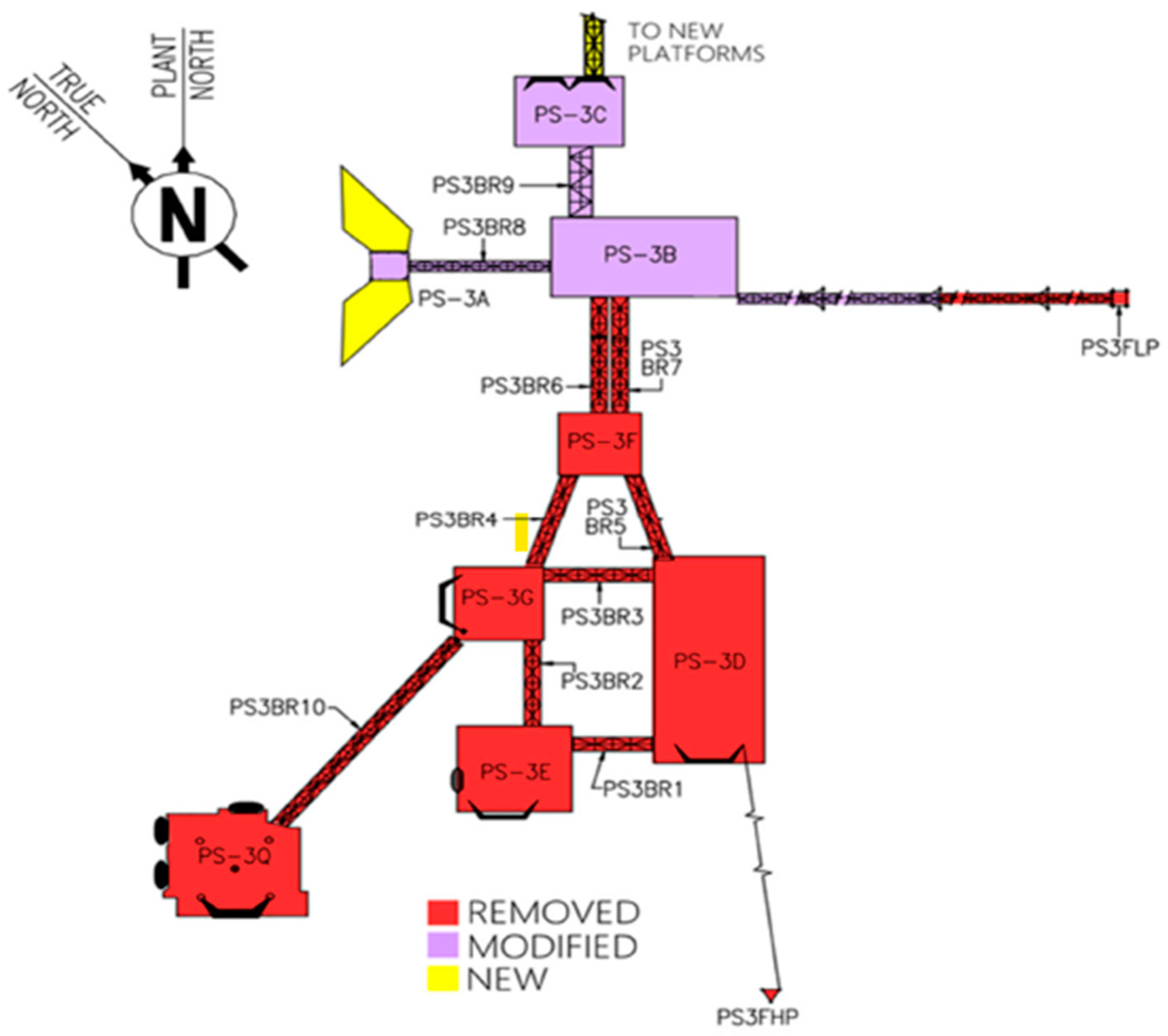

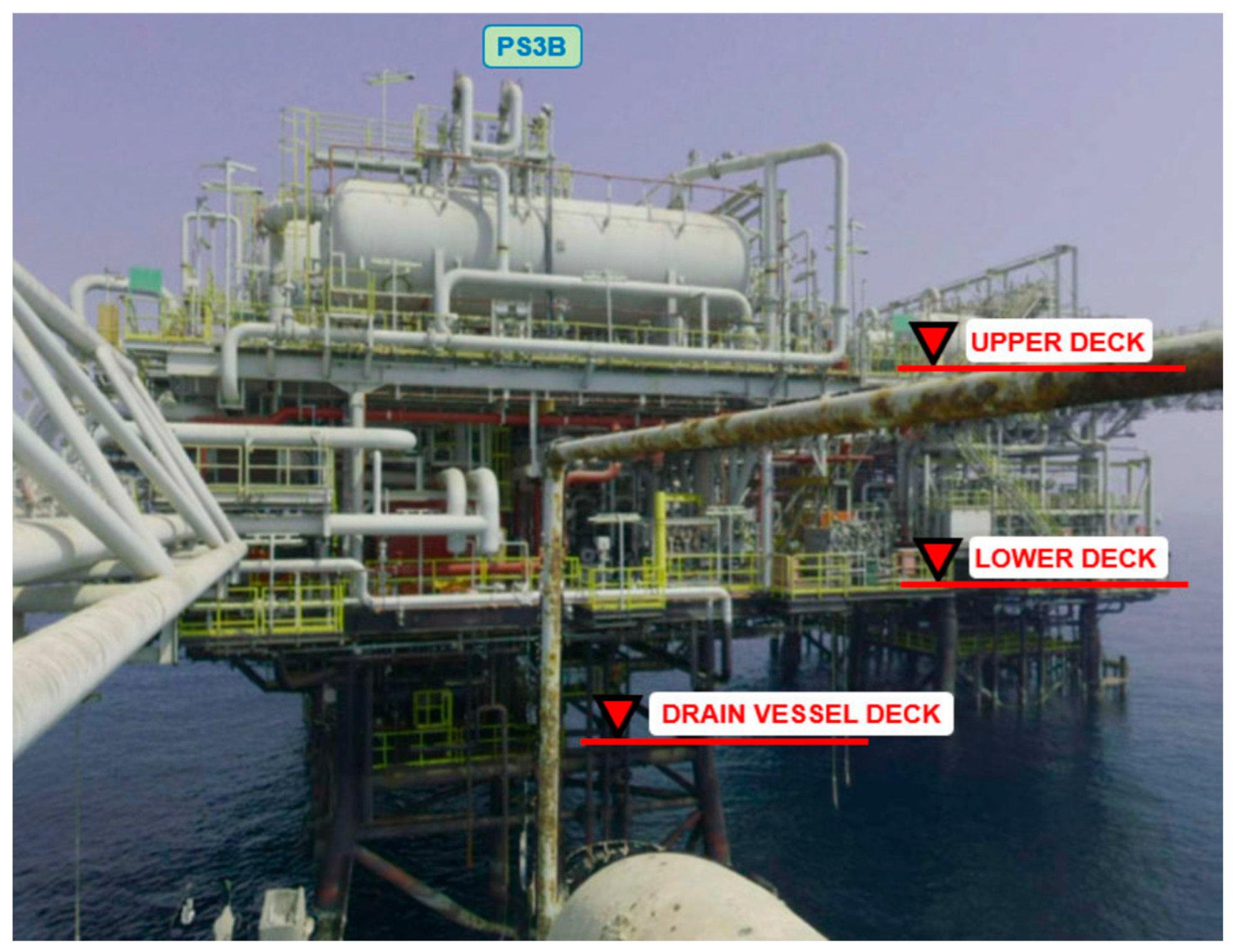

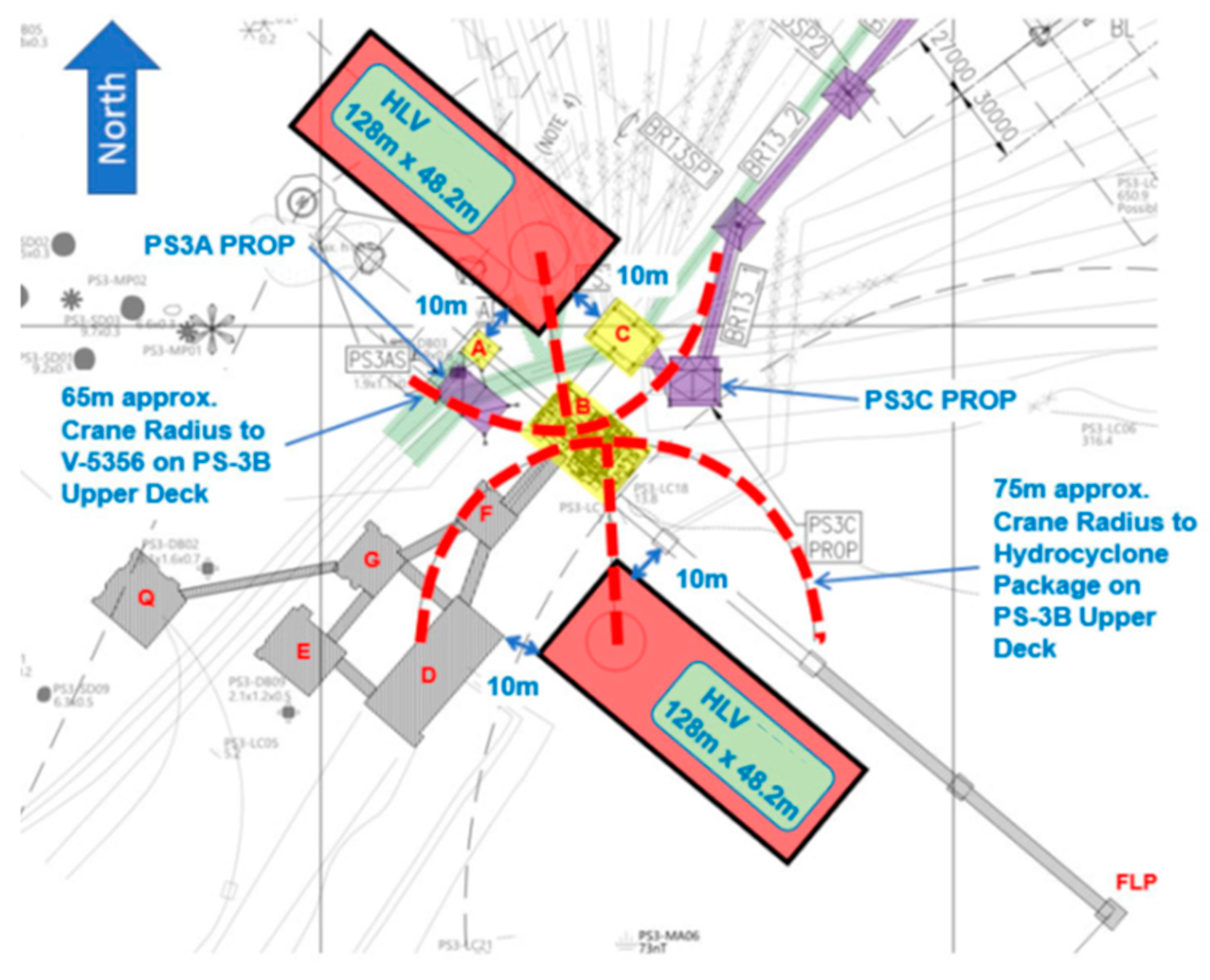

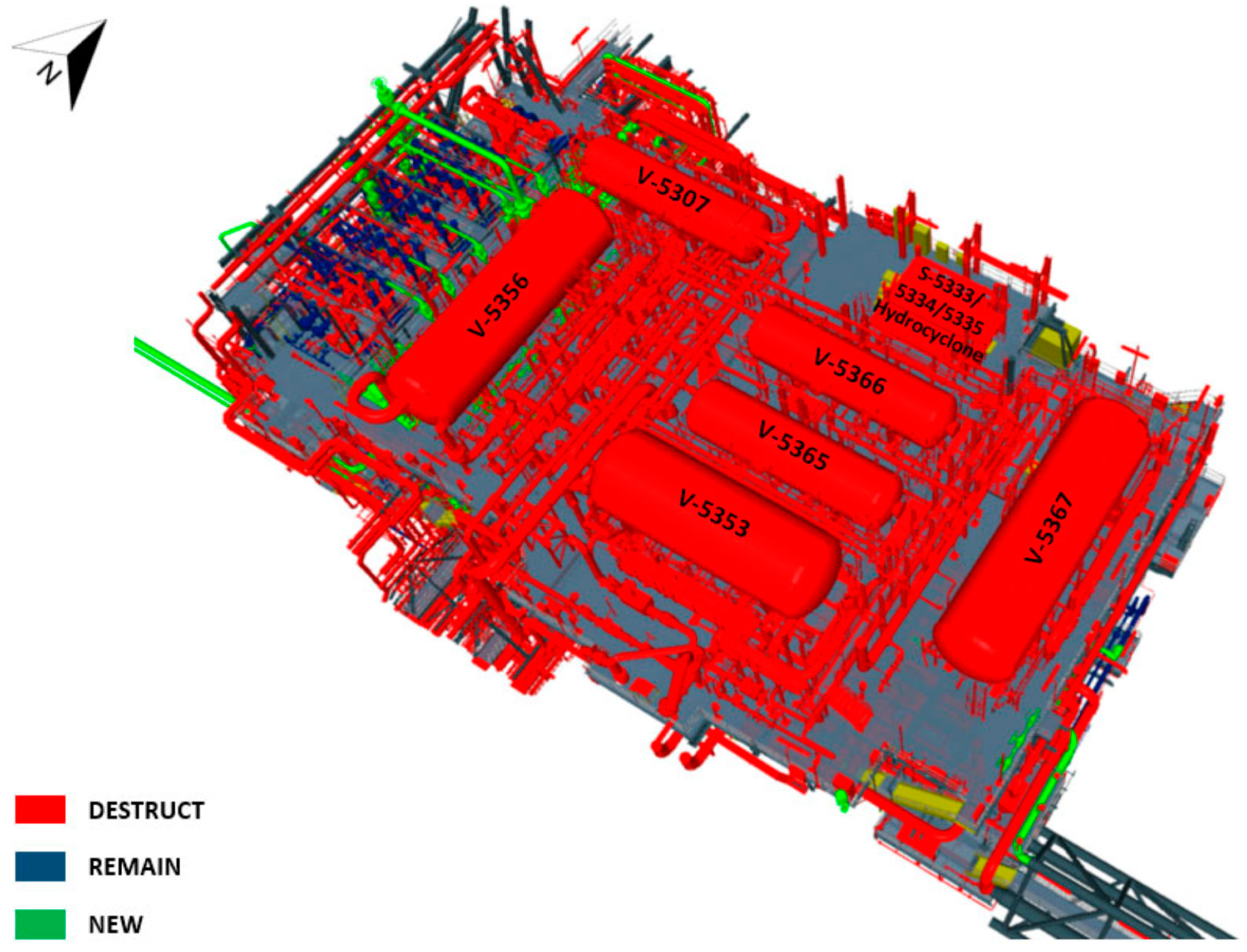

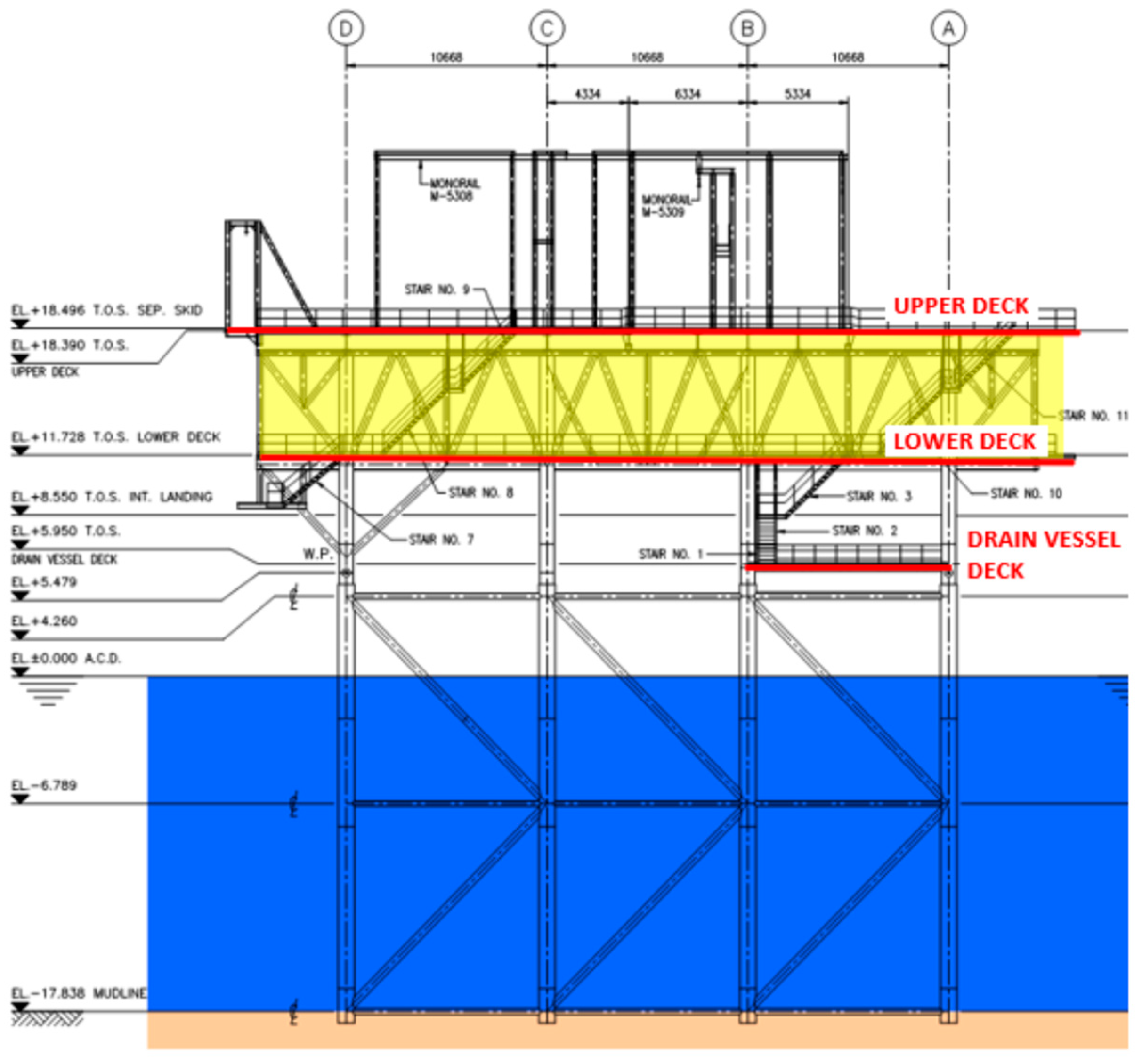
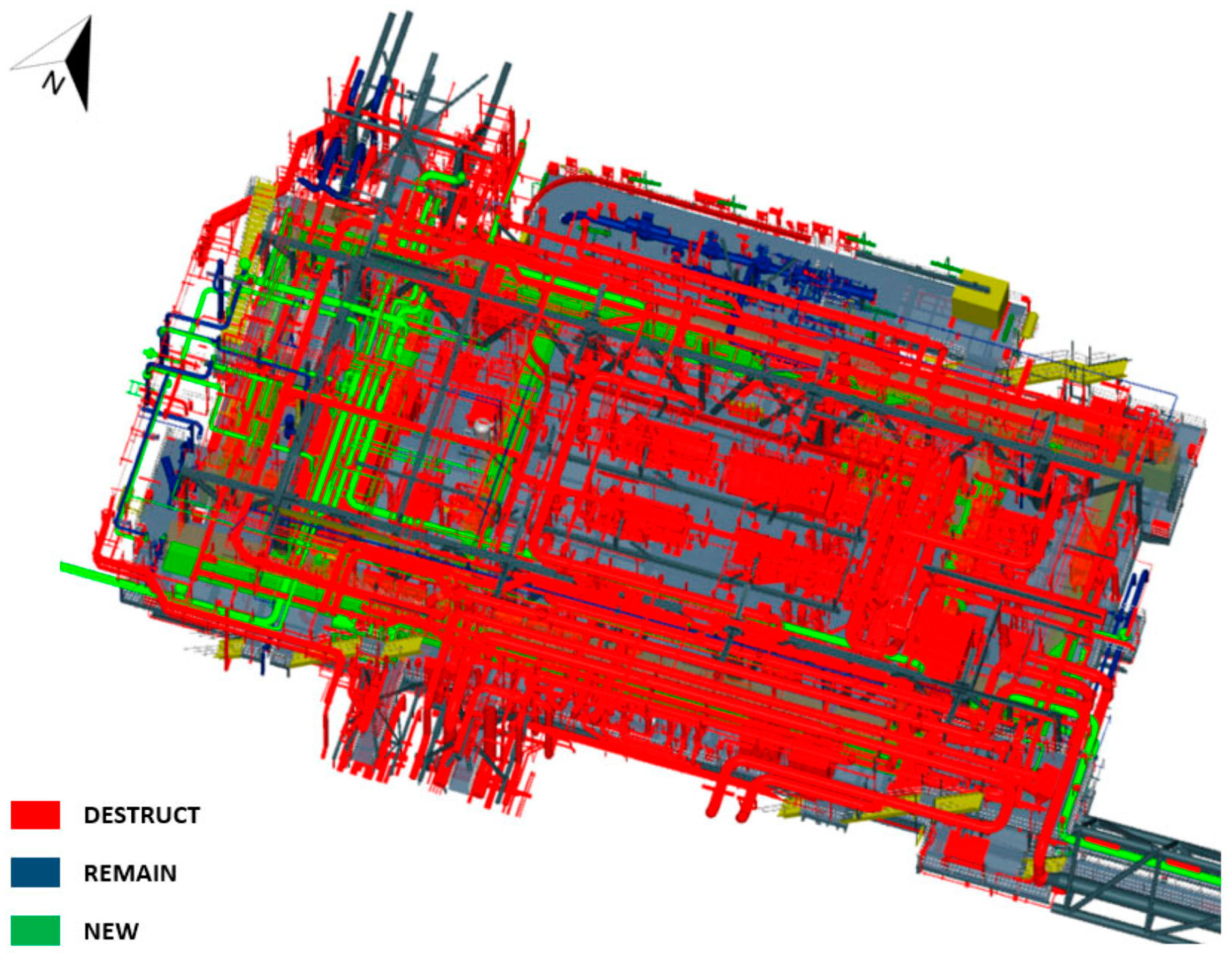

Disclaimer/Publisher’s Note: The statements, opinions and data contained in all publications are solely those of the individual author(s) and contributor(s) and not of MDPI and/or the editor(s). MDPI and/or the editor(s) disclaim responsibility for any injury to people or property resulting from any ideas, methods, instructions or products referred to in the content. |
© 2024 by the authors. Licensee MDPI, Basel, Switzerland. This article is an open access article distributed under the terms and conditions of the Creative Commons Attribution (CC BY) license (https://creativecommons.org/licenses/by/4.0/).
Share and Cite
Reda, A.; Amaechi, C.V.; Shahin, M.A.; McKee, K.K. Field Redevelopment and Weight Shedding for Decommissioning of Offshore Facilities. J. Mar. Sci. Eng. 2024, 12, 1331. https://doi.org/10.3390/jmse12081331
Reda A, Amaechi CV, Shahin MA, McKee KK. Field Redevelopment and Weight Shedding for Decommissioning of Offshore Facilities. Journal of Marine Science and Engineering. 2024; 12(8):1331. https://doi.org/10.3390/jmse12081331
Chicago/Turabian StyleReda, Ahmed, Chiemela Victor Amaechi, Mohamed A. Shahin, and Kristoffer K. McKee. 2024. "Field Redevelopment and Weight Shedding for Decommissioning of Offshore Facilities" Journal of Marine Science and Engineering 12, no. 8: 1331. https://doi.org/10.3390/jmse12081331
APA StyleReda, A., Amaechi, C. V., Shahin, M. A., & McKee, K. K. (2024). Field Redevelopment and Weight Shedding for Decommissioning of Offshore Facilities. Journal of Marine Science and Engineering, 12(8), 1331. https://doi.org/10.3390/jmse12081331









